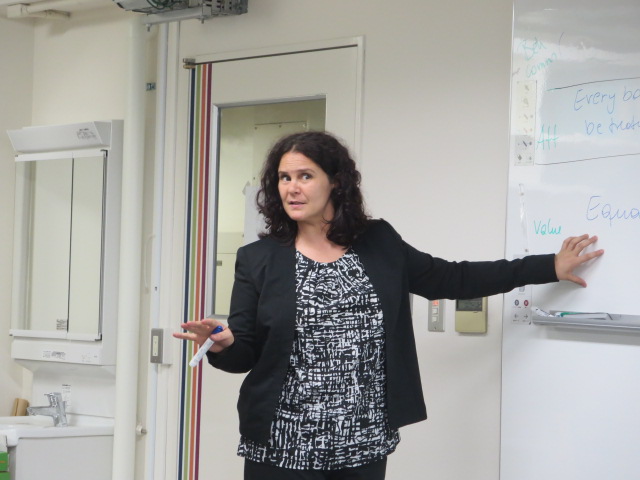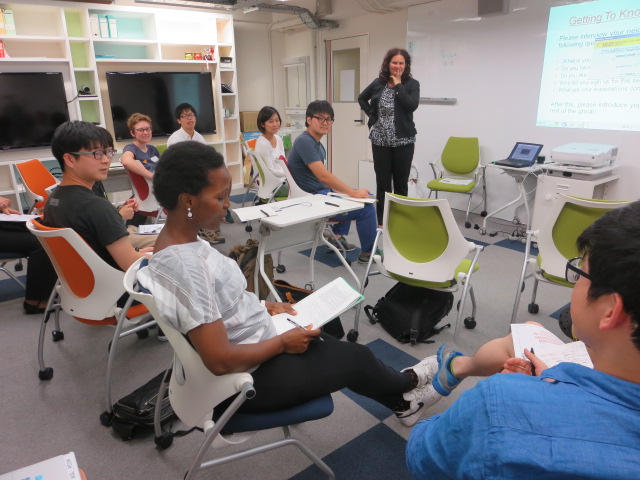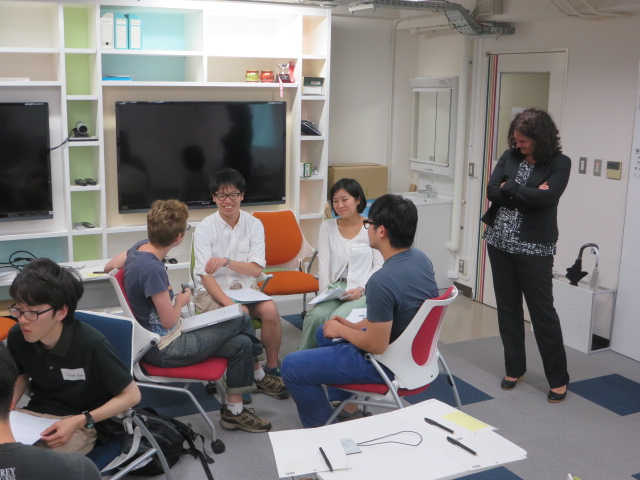

2015.07.13
H27年度前期山田道場WHAT'S GOING ON 『Introduction to Cross-cultural management』
Guest Speaker and facilitator: Parissa Haghirian, Professor, Liberal Arts, Sophia University
On 06/29 we were pleased to invite Dr. Parissa Haghirian, Professor of International Business at Sophia University, to Yamada-dojo for the first in a series of lectures about cross-cultural communication and management.
With a bi-cultural Austrian-Iranian background, a doctorate in International Business and the experience of having lived in Japan for many years, Dr. Parissa had much to teach us about this complex subject.
 We began by trying, as a class, to define what culture was. Although everyone had a slightly different perspective to offer -- culture is shared behavior; shared history; food; traditions -- Dr. Parissa showed us how these different ideas could all be seen as part of a 'value-attitude-behavior' model of culture. The model can be described as follows: in a particular culture, we share certain values, such as valuing the group over the individual. These values lead to certain shared attitudes, such as that it is better to work as a group than on your own, and to certain behaviors, such as having strict rules that everyone in a group respects and closely follows.
We began by trying, as a class, to define what culture was. Although everyone had a slightly different perspective to offer -- culture is shared behavior; shared history; food; traditions -- Dr. Parissa showed us how these different ideas could all be seen as part of a 'value-attitude-behavior' model of culture. The model can be described as follows: in a particular culture, we share certain values, such as valuing the group over the individual. These values lead to certain shared attitudes, such as that it is better to work as a group than on your own, and to certain behaviors, such as having strict rules that everyone in a group respects and closely follows.
 It was eye-opening to see just how differently our core values, which we think are fundamental and unchangeable, can be seen from the perspective of other cultures. With five or six countries represented by members of our group, we had the chance for a fascinating discussion about this value-attitude-behavior model of culture, sharing many other examples from our home countries.
It was eye-opening to see just how differently our core values, which we think are fundamental and unchangeable, can be seen from the perspective of other cultures. With five or six countries represented by members of our group, we had the chance for a fascinating discussion about this value-attitude-behavior model of culture, sharing many other examples from our home countries.
 One of the most important insights gained from thinking of culture in terms of values, attitudes and behaviors was that the vast majority of culture is invisible to people from outside that culture. When we travel to a different country, we can observe people's behaviors, but we can only interpret their behavior in the context of our own values and attitudes. This leads to the stress, confusion and frustration that many people experience upon finding themselves outside of their own culture.
One of the most important insights gained from thinking of culture in terms of values, attitudes and behaviors was that the vast majority of culture is invisible to people from outside that culture. When we travel to a different country, we can observe people's behaviors, but we can only interpret their behavior in the context of our own values and attitudes. This leads to the stress, confusion and frustration that many people experience upon finding themselves outside of their own culture.
Is there anything we can do to avoid this stress?
Unfortunately there were no easy answers Dr. Parrissa could offer us -- cross cultural experiences will always be challenging. However, it was reassuring to hear that it is possible to do well in an international environment as long as we are prepared to be flexible up to a point; our core values will remain our own, but being able to change our behaviors to fit the culture we find ourselves in is a skill that we absolutely will have to learn.
(Reported by Ania Brown, M2, Energy Science, a 2014 member of AGL)









